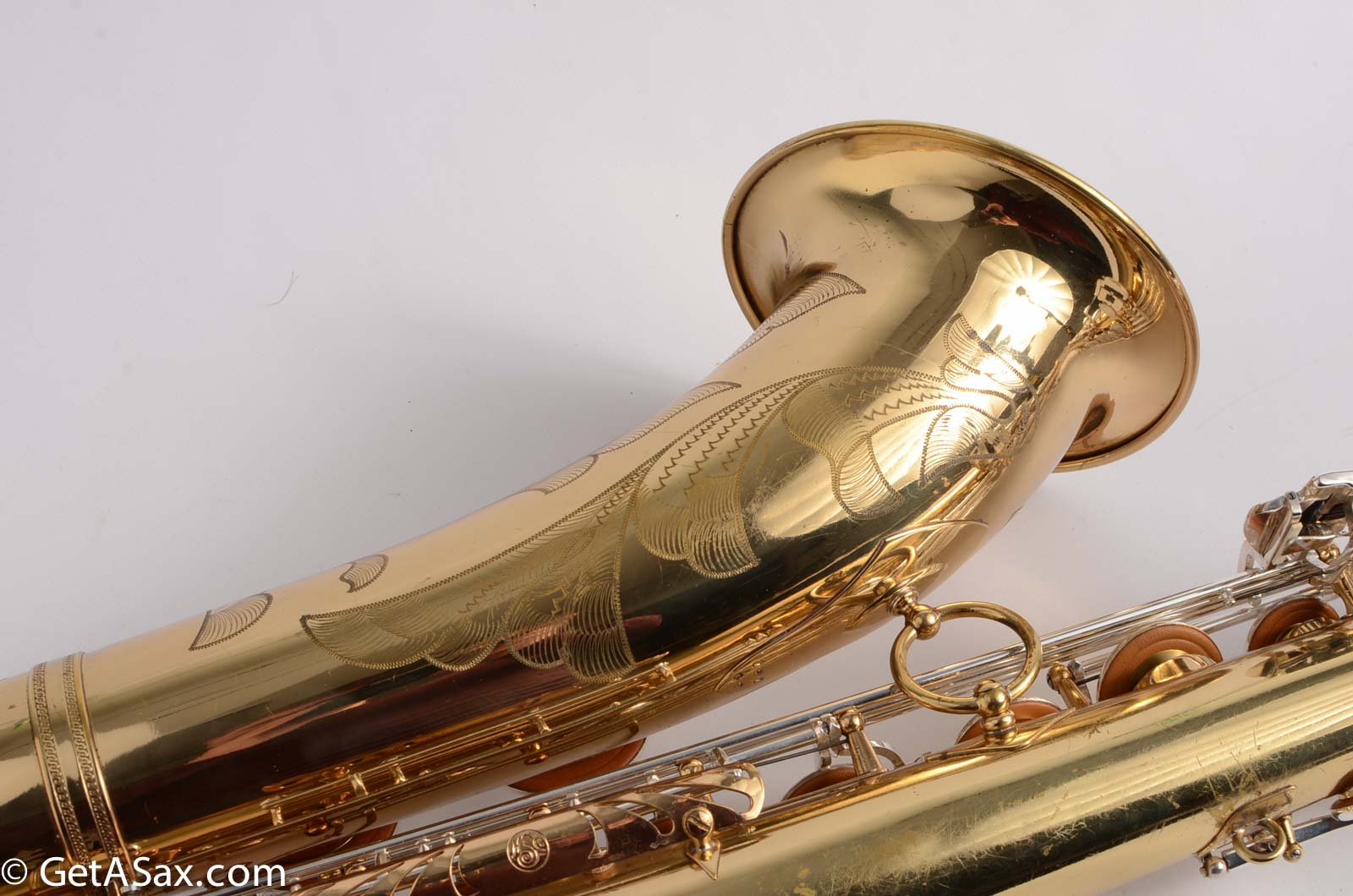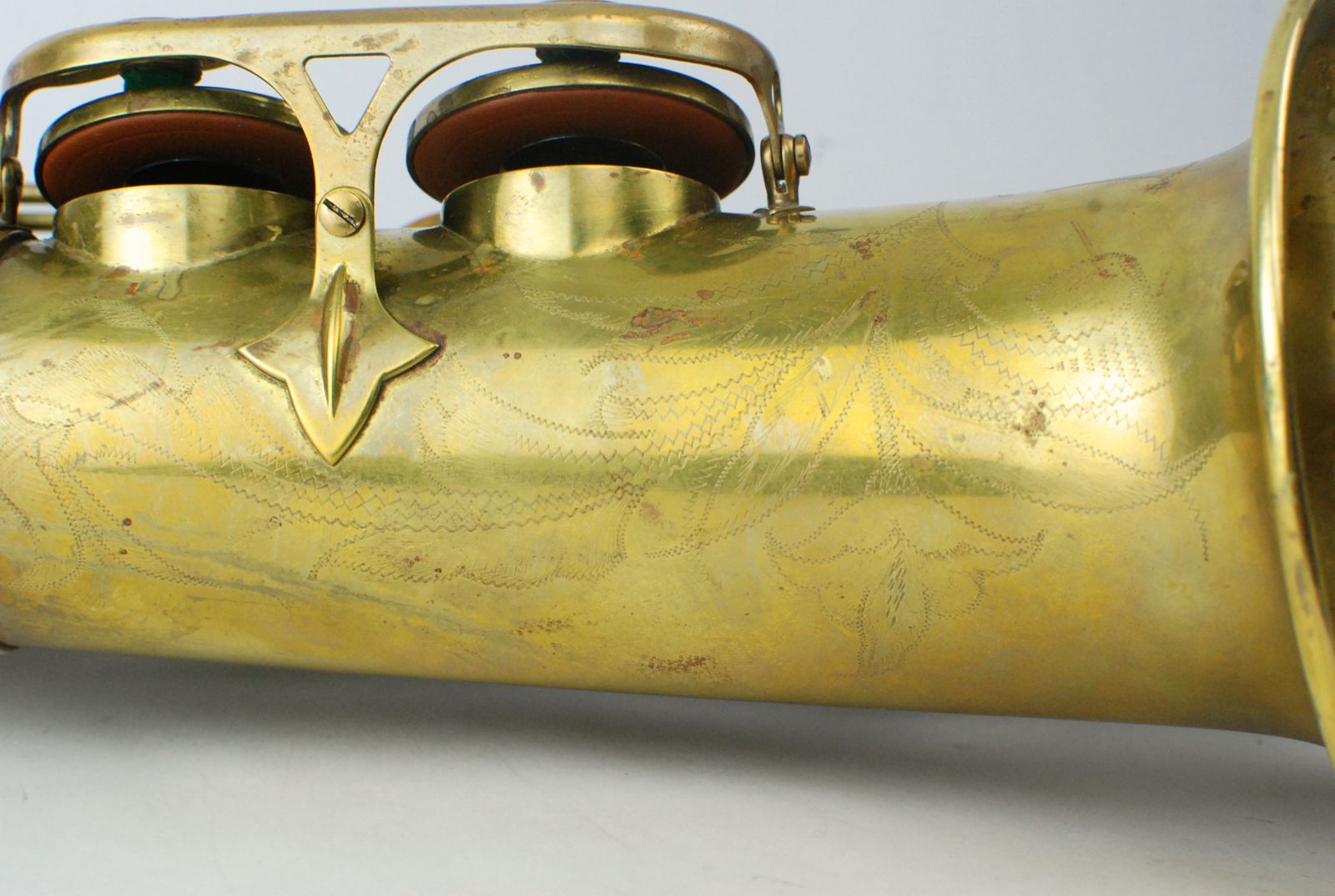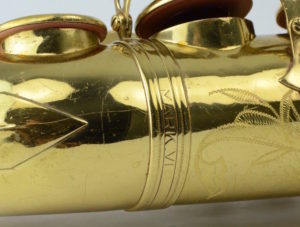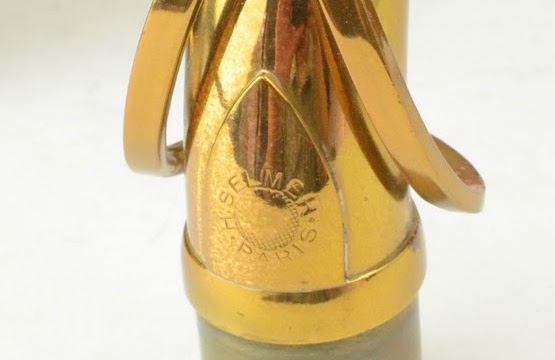In the previous post, we looked at how to identify whether your Mark VI was assembled and engraved in the European market, or assembled and engraved for the American market. We also looked at what typical examples of original lacquer, American-assembled Mark VI’s look like in every major time period.
In Part 2, we will look at some different European engraving and lacquer styles, and then we will talk about how to distinguish a relacquered Mark VI from an original lacquer Mark VI.
**Note: This is an article that I plan to improve in level of detail over time as I get more and better photos of different types of Euro-assembled and relacquered Euro-assembled Selmers. Hopefully it is still helpful in the current form.
European-assembled Selmers are often all lumped together when we talk about vintage Selmers. We basically think American vs Euro. But in reality, there were multiple distributors, each doing its own thing. Many Euro-market VI’s were assembled and engraved in France. But quite a few others were engraved in London. That ‘London’ stamp on the bell actually means something! London-distributed Selmers were not only sold in Great Britain, but also at least in Ireland, Canada, Australia and New Zealand. Here are some examples of distinctive British engraving patterns on lacquered saxophones.












To round out our tour of the Mark VI soprano, the next horn is a rare original lacquer American-engraved Mark VI soprano 97xxx. If you have already toured the American engraved Selmers in the previous post, then you will be familiar with this kind of lacquer already.



Here is a later British market Mark VI serial 143xxx. The lacquer is lighter than the earlier ones. I think these were all lacquered in France by this point. Only the earlier British Mark VI’s have the darker, fragile lacquer shown above.

Here is a French Assembled and lacquered Mark VI 143xxx. Compared to the British market alto immediately above, you can see a big difference. However, this may be due to the life the horn has lived, or a difference in batches of lacquer, rather than to a difference in where they were lacquered. I think all euro VI’s were lacquered in France by this point!








OK so much for typical original lacquer and engraving on Euro-assembled Mark VI’s.
Now we move on to some examples of relacquered Mark VI’s to help you get a feel for them.
In what follows, I will be focusing on American-engraved Mark VI’s, but everything that I am saying transfers also to Euro Mark VI’s. I don’t have enough photos of relacquered Euro-assembled Mark VI’s to give good enough examples in most cases.




In the above two pairs of images, the first two show an original lacquer 58xxx Mark VI next to a relacquered 57xxx Mark VI. These two horns would have originally had the same kind of lacquer. The relacquered horn (on the right, second image) was buffed to a bright shine and covered with a clear lacquer that is used on modern saxophones today.
In the second pair of images, you see an original lacquer 61xxx tenor next to an unlacquered 60xxx tenor. Is the unlacquered Mark VI stripped original lacquer, or a stripped relacquer? Sometimes it is hard to tell, if the relacquer job was done very well without buffing (lacquer chemically stripped), but in this case, it is a stripped relacquer. If you look closely at the engraving, there are several places where cuts that should continue to be sharp fade out. This fading out is not a result of normal use of the horn in most cases, but of someone checking his text while operating a buffing wheel and getting a wee bit too aggressive for a moment. Particularly on a 60xxx which originally had very deep, sharp engraving, this is clearly a stripped relacquer.



The above example is a Selmer Balanced Action, but I couldn’t resist including it. The Balanced Action (original lacquer) on the top has the most gorgeous honey gold lacquer that you have ever seen. The Balanced Action below shows absolutely no buffing to the engraving on the bell. Super sharp, and the lacquer is dark, nitrocellulose like Selmer used. But it’s not the right lacquer for a Balanced Action. That was the point of taking you through the tour of Selmer lacquer over time. This horn has lacquer probably from the late 40’s or early 50’s (the dark, chocolatey, nearly opaque kind). It was most likely relacquered at that time.

To finish up this post, I want to comment in detail on a couple of photos. The above photo is a classic example of a relacquered Selmer Mark VI. There are several features to notice that you can look for. For one thing, you can see that the engraving is rounded at the edges of the cuts and filled in with a thick layer of lacquer. Originally, Selmer would apply several coats of lacquer, then engrave, then apply a final thin overspray of lacquer. On very pristine Mark VI you can even still see this last coat on the edges of the original pads. So you have to look closely at how sharp the engraving is. If this were a later serial Selmer, the lacquer color would almost look correct. It would still be too clear, not warm enough, and too shiny.
On Selmer relacquered with the right color lacquer, you have to look more carefully. Here’s an example.

On this horn, you can see that it is a Euro-engraved Mark VI, and the lacquer is basically the right color, but there is engraving worn away underneath the lacquer. Since the lacquer is a protective coating over the brass, it is not possible for the brass to wear down without the lacquer first getting worn off. So this is clearly relacquered. Still, if you can spot this, and know what you are looking at, you are doing pretty well!
Besides using the above guide to spot non-original lacquer, here are a few more things to look for in spotting relacquers.
1. Check the palm keys and the pinky keys for wear or pitting in the brass under the lacquer. It would look wavy when held up to the light since there is worn off brass from heavy use on those key touches. Don’t go crazy looking for scratches under the lacquer though. Scratches aren’t a reliable indicator, because it is usually very hard to distinguish a light scratch in lacquer made by a stand from a scratch under the lacquer. Any decent relacquer job should have removed scratches anyway.
2. Check the nooks and crannies around post feet and key guard legs for red rouge. A reddish look only in the engraving itself can just be oxidizing brass where air got in there, but if there are other signs of refinishing, it could also be buffing compound. If there’s a ton of red, it’s pretty likely relacquered. If there’s only a tiny amount in the deepest spots, and everything else looks original, it could have been like this from the factory originally.

3. If the lacquer just looks dull and drab, it is more likely to be non-original. Even worn Selmers are pretty shiny where any lacquer is present. On an unengraved Mark VI, this is a good indicator.
4. If you have seen an original Mark VI before, you can look for duller edges in places that should be sharp, like the edges of keys, the ribs on pad cups, and the bell to bow ring. All the scrollwork or vertical lines should be intact there. See how the lines on the bow ring are worn down and the lacquer reflects light unevenly. This is typical of a relacquered Mark VI.






What is my Mark vi alto worth.Its European Model.Serial number 147,000 original lacquer.No damage and no solders original case.Fresh overhaul and brand new blue springs.Lacquer is 95% remaining.No slop in anything.I bought it on ebay in 2002.It was bought in 1967 naw and the owner died in 1969.The wife stashed in the closet at that time and it stayed there until I bought it in 2002.The neck still has beautiful blue around the S on it.One scratch about one inch long and and the post on the bell keys have a little rust from setting in th closet and natural age.
Hi David, if you want to email me photos directly at getasax@gmail.com I can help you to get an idea of what your Selmer is worth in today’s market. Thanks! Brian
I’ve heard the old nitrocellulose lacquer (pre 1959 ish??) called bug juice. Is there any meaning to that? How did the lacquer formula change?
Not sure, but it could be either because lacquer is sprayed on like bug spray, and/or because the spray is similar in composition to lacquer. I know bug spray will cause nitrocellulose to degrade, so there may be a similar solvent involved in both kinds of spray.
If you’re interested, the ‘bug juice’ reference I came across is here: http://www.saxontheweb.net/SOTW_Archive/selmer/02-02-03/boardset-saxweb-boardid-selmer-thread-41-spec-4731478.html
>> used a lacquer that used to be called ‘Bug Juice’ as it was truely made from some beetle. This lacquer is pretty unstable.
I was never sure if the poster was mistakenly thinking about the french-polish element Shellac (https://en.wikipedia.org/wiki/Shellac), or maybe was accurate that a bit of shellac was mixed in with the nitrocellulose to provide colour?
Hi Brian,
Super article on European vs American assembled and relacquered or not! I found your information useful as I am selling my Mark VI s/n 121443, and I’m trying to educate myself on this horn so that I can best represent it. My horn was purchased used in Berlin, Germany, in 1969, and was (unfortunately) relacquered. Although the lacquering was impeccably done, it limits the market and price. In addition the scroll work, we noticed another difference betw. the European and the American versions, and that is the “Mark VI” engraving has been omitted from the horn.
We’re asking 6k for the horn and had a few nibbles, but found that despite the outstanding condition of the horn and the age/serial number, buyers are looking specifically for original condition American versions.
Thanks again for your article!
Sure there is no Mark VI marking? I have a 62000 series tenor and the stamp is just above the thumbrest. It’s pretty faint though, so on a relacquered sax it may not be legible.
Hello Brian,
Congratulations for your article! I wonder if you could share some information about silver plating on vintage Selmers. How to determine if plating is original? Is there a difference in color/plating quality or other characteristics between American assembled and European assembled?
Thank so much!
Thiago Nicodemo
The short answer is that there are very few silver plated American-assembled VI’s. (I will discuss London-finished ones in a minute). I have seen only one American-engraved silver plated VI that I was sure was original, and the silver looked just like the Euro-assembled silver plate. Original silver is almost always on a Paris-finished Selmer, and it is a smooth, even coat of silver plate that does not have any “matte” appearance. It usually has a bluish tint to it. The British market VI’s can be a more warm, creamy looking silver plate, and they usually have a combination of matte silver and bright silver. And they often have Paris-done engraving. I hope that’s helpful. As far as spotting re-plated silver versus original, you have to look for signs of buffing, and for signs of wear in the brass under the silver. Not scratches or dings, but actual wear, especially on touch points like the palm keys, side Bb, Eb/C and on the back of the body. It can be hard to tell sometimes.
I have a Selmer tenor sax #120737 which I Believe it’s a mark 6. but it does not have Mark 6 engraved anywhere. Could it still be a Mark 6.
Thank you,
Yes, this is a Mark VI based on the photos you sent me. Cheers, Brian
such a brilliant article. I used to have a MK VI which as the repairer said ‘if it was a horse I’d shoot it’ was very badly battered. I struggled with it for years and then went to a Mauriat. After a few years with that I am now in the market for a MK VI again. I have a friends to try (not buy) at the moment 1963 stripped version and have one to try (possibly to buy) on Friday. This is apparently a 1964 original lacquer rare(?) American finish. Perhaps when I get it I could send you some photos and you could advise me as to why it’s rare?
Juts a GREAT article! many thanks
Thank you for writing this, I really enjoyed your article.
I have a 166,xxx series Mark VI tenor that I bought back in ’89 for $1200.
The horn always seemed slightly brighter in color than the other Mark VIs in our high school Jazz Band and brighter than the other two Mark VIs my parents owned. Additionally, several of us noticed that my horn had an additional flower engraved further towards the back on the left side of the bell. It matches the typical engraving on the front of the bell. Do you know if the engravers had some artistic liberty to add something like this?
Many years ago, I had one tech tell me that he thought the color wasn’t correct and that the horn was a relacquer. About ten years ago I had a well known tech and studio musician in the Baltimore area repad the horn and he said that the lacquer was definitely brighter but it didn’t show any signs of buffing and thought that maybe it was a European horn that was factory relacquered and then engraved at the same time. Was this even an option? Thanks!
You’re welcome. I’m still trying to improve and update it as I learn more.
Great work; informative. I have a Mark VI s/n M. 63xxx and it plays beautifully however (a big however), someone owned the horn before me and had it lacquered. Strange. The engravings look good and thanks to your research and sharing I am able to identify where the engraving happened. I am getting new pads and considering having the horn stripped. What are your thoughts/suggestions on getting the horn stripped?
You might consider getting it re-engraved rather than stripped. I will usually only strip lacquer from a horn if the current lacquer is very deteriorated, or if the lacquer job was done poorly. Lacquer protects the brass, so if you want to see the engraving better, just re-engraving would do the trick. Getting it overhauled properly should make it play its best. You want to be picky about finding the best saxophone tech whose repair philosophy includes taking the time to actually fix everything. That’s the most important single piece of advice I have.
being a engraving buff – where King, Conn and Selmer had some serious competition, I enjoyed reading this article.
Of course, I would like to see more examples of earlier Selmer’s – both my SBA alto and tenor have the same engraving, but my early BA alto seems to have a strange combination of Art Deco, a very detailed sunburst engraving (surrounding a “B.A.” initials – on the bell, just above where you would see the MK VI on those later horns)and, finally flower engraving on the bow. Has any1 seen this type? (early 21xxx)
Yes! This is British engraving and has lots of distinctive (and variable) features. I have had some like this too. Sometimes there’s a treble clef, or a sort of sunburst coming out from the center. Is yours lacquer or silver plate?
Thank you for your informative articles.
Right now I‘m offered an „original gold plated“ 160k Tenor.
What irritates me is, that it is unengraved like lots of the silverplated French horns and that I never came across a comparable one in this finish.
Could it be original?
Thanks a whole lot.
Many folks selling a horn have trouble distinguishing gold lacquer from gold plate. You would need to see it in person to make a determination. You can look for signs of buffing on the key arms and edges of key touches to tell whether the plating is original or not, even if there is no engraving on the sax.
Great article.
I have a question. I’m looking at an old Mark VI to buy, the lacquer color seems right & the engravings are sharp. But there’s a greenish white build up in some of the lettering engraving on the bell and around some of the posts. I’m not sure if it’s some kind of mold or(after reading your article) maybe white buffing compound.
On an older Mark VI I owned there was a green buildup around the posts, even though the horn had original lacquer, but I’ve never seen greenish white discolorations. It almost has a chalky effect like household metal polish residue.
Have you seen this this type of thing before?
Thanks!
Yes, these might be two different issues. The green might just be a type of patina from the copper in the brass. The whitish stuff I have seen before when people tried to polish the horn with the wrong type of polish – like a metal polish, and it got in the nooks and crannies of the stamping, engraving, and around post feet etc. Maybe the polish exposed some brass and that got a green patina from being exposed to moisture over time? In any case, disassemble, clean, and overhaul, and it should look good.
Do you know why type of flower is engraved on the Selmer 1963 Mark V1? My research suggests it is Leontopodium nivale, commonly called edelweiss, however the engraved flower on the instrument doesn’t have the five to six small yellow clustered spikelet-florets that edelweiss has. Any information would be appreciated.
I’m really not sure on that one. I agree that it doesn’t have the petals like Edelweiss, which would be a strike against that theory. Floral engraving is often pretty generic, so I’m not sure how easy it will be to connect it with a particular flower.
is the engraving unique to each individual horn?
No, it is pretty much the same pattern from start to finish.
I have a Euro Mark VI from the 86xxx era and it has a small amount of lacquer in the pearls, some more than others depending on the use of the keys.
My question is, is this from the factory or are the pearls over-sprayed from a re-lacquer?
Also, you made mention of overspray on the final coat showing up on the American assembled horns around the edge of the pads but no mention of whether this is also done on the Euro Horns as well?
My horn shows as one that has origonal lacquer and origonal pads but no signs of a overspray around the edge of the pads but the engraving is sharp and filled.
Can you email me some photos please? I don’t think the euro original pads VI’s always have lacquer on the pads. I could be wrong, but they often appear to be padded after being lacquered.
hi, I was wondering whether the differences in lacquer between American- and European-assembled Mark VIs make any significant differences to the sound? Or is it mostly an aesthetic thing? Thanks for all the useful info!
I would be in the mostly aesthetic camp. There are some substantive differences between Euro and US assembled, and they have to do with 1. The US Assembly has some of the best factory setup ever done on a saxophone. Many of those horns still feel better than almost any other horn today, 60 years later. When you play a horn, you’re often playing the overhaul, and that makes the US-assembled VI’s stand out. 2. The bow ring is soldered on the US-assembled VI saxophones. That prevents leaks and maybe makes the bell keys resonate more.